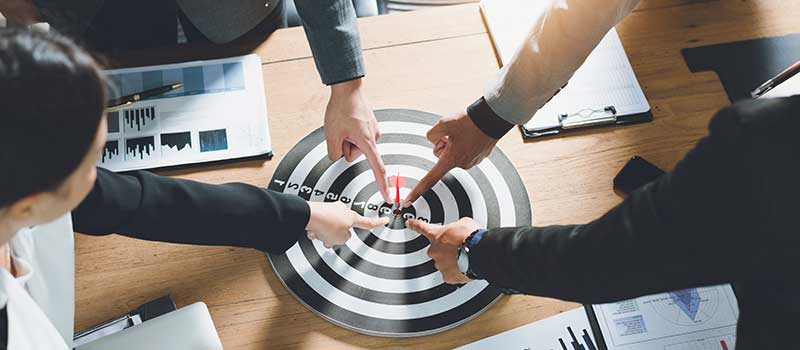STP marketing, the abbreviation for segmentation, targeting and positioning, is one of the most important concepts for modern marketing.
While mass marketing is akin to spraying the market with a machine gun, the STP model takes a sniper-like approach in getting specific about the target and the conditions they exist in.
STP represents the change in marketing from a product-centric focus to a customer-centric one, so brands can analyze and understand their target audience and position themselves to better appeal to them.
In this article, you’ll learn what STP marketing is, its benefits and top examples to learn how to leverage it in your brand strategy.
What Is STP Marketing?

STP marketing is a three step model that allows brands to
#1 Segment Their Market
#2 Target Specific Segments
#3 Position To Appeal To Those Segments
It allows brands to develop hyper-targeted positioning and messaging which translate into more effective marketing strategies more relevant to their targeted groups.
STP is an acronym for the three described steps: Segmentation, Targeting, and Positioning.
Using the STP process, brands are armed with a powerful and highly relevant understanding of their audience, their challenges, fears, desires, wants and needs.

In other words… They have everything they need to resonate and influence the buying decision.
The segmentation, targeting and positioning model is highly effective as it trims the fat and unnecessary cost and effort of marketing to groups who are unlikely to want or need what the brand has to offer.
Essentially, marketing becomes cheaper and responses are dramatically enhanced.
On the flip side, brands that avoid the STP approach and use broad-based messaging and positioning are less relevant to their audience and have to work much harder to achieve the desired response.
In fact, almost 60% of customers say that personalization directly affects their decisions to buy from certain brands, while 44% agreed that experiencing personalized shopping definitely influences them to buy from that brand again.
What Use STP Marketing?

The segmentation, targeting and positioning model is highly effective as it trims the fat and unnecessary cost and effort of marketing to groups who are unlikely to want or need what the brand has to offer.
Essentially, marketing becomes cheaper and responses are dramatically enhanced.
On the flip side, brands that avoid the STP approach and use broad-based messaging and positioning are less relevant to their audience and have to work much harder to achieve the desired response.
In fact, almost 60% of customers say that personalization directly affects their decisions to buy from certain brands, while 44% agreed that experiencing personalized shopping definitely influences them to buy from that brand again.
Benefits of STP Marketing

I’ve already alluded to some benefits a little earlier though enhancing the efficiency and the effectiveness of campaigns and ultimately attracting more relevant buyers is without question the main driver behind the STP approach.
PRO Brand Strategy BluePrint
Build Brands Like A Pro Brand Strategist

Higher Relevance To Buyers

Through segmentation and targeting, brands can refine their position, retune their message and hit the right chords with the segments of the market that want or need what the brand is offering.
The more relevant the message, the more the audience see themselves in the story or the more acute the pain points are throughout the copy, the more likely the prospect is to sit up, take notice and pull their wallet out.
Explore Brand Strategy
Programs & Tools
Lower Marketing Costs

Another key benefit to using the STP process is the reduction of cost on marketing spend.
Broader-based marketing that aims to cast a wide net, needs to spend money to cast that net.
There is a lot of wastage of marketing budget by using a wide net approach while laser focused STP marketing aims for specificity and relevance over media spend.
This is especially important for smaller businesses that simply don’t have deep pockets to spend on their marketing campaigns.
The more efficient the campaign the better.
More STP Benefits

The segmentation is what segregates the real potential customers from the ones that may not make the decision to buy from the brand.
STP is how your business will avoid the risks of deciding how, where, when and whom to market for. It’s a massive gain in marketing efficiency and a great reduction in marketing costs.
Other STP marketing model benefits include:
Increased sales through highly targeted campaigns
More engaged followers who feel understood
Avoiding campaign wastage by attracting the right audience
Offers smaller businesses a seat at the table
More effective marketing budget allocation
Deeper insights into the customer
How to Apply The STP Marketing STEP Formula

If you want to apply the STP marketing model to your business, follow the steps in the STEP formula which you’re about to learn.
The STEP formula is the easiest way to summarize and memorize the STP marketing process.
Segmentation + Targeting = Positioning
Follow each step in the formula to arm your brand with the ability to reach customers more effectively.
Step #1: Segmentation

The first step to start implementing a robust STP marketing strategy for your brand is by segmenting your customers. The goal is to segment all the possible groups in your target market based on the criteria you judge important for your products or services.
There are four popular types of customers segmentation:
Geographic segmentation: Define this segment by dividing your audience according to their country, region, state, city, province, neighbourhood, and so on.
Demographic segmentation: Segments your customers based on their age, gender, education level, occupation, marital status, ethnicity and sexuality.
Psychographic segmentation: The audience is segmented to define who the customer is through their opinions, activities, hobbies, lifestyle, etc.
Behavioral segmentation: in this segmentation type, you can divide your audience based on their purchase behavior (in other words, by what they buy, what they browse to buy, how often they are buying, etc)
Step #2: Targeting

The second step of the STP marketing process is targeting.
Your goal on this step is to look at the segments created on the first and see which segments are most likely to convert and ultimately become customers.
Highly sought after target segments might include any or all of the following:
High Profitability
Low Cost of Acquisition
High Growth Potential
When analysing your segments look for the following
Size: How big is the segment, how likely is the segment to grow in the future and what does the growth potential look like.
Profitability: Uncover which segments are willing to spend more on the products or services you have to offer. I.e. which segments have the higher lifetime value probability.
Reachability: It’s important to understand how hard or easy it is to reach the segment with your marketing strategy. The best way to do this is to include customer acquisition costs to see which segments are higher or lower. A higher customer acquisition cost means lower profitability.
Consider these factors carefully when defining your targets to ensure you target the segments that represent the best opportunity for the brand to grow.
Step #3: Positioning

Once you’ve segmented your market and clearly defined the segments your brand or campaign will target, now it’s time to move to the final step of the STP Marketing process which is to position effectively.
Whether your targeting a brand or it’s products or services, positioning is not done in a silo. The position a brand takes must consider the other competitive players to ensure that the brand’s offering is unique.
Without effective positioning, the offer will represent more of the same which is very easy for the market to ignore.
The ways to position a brand are countless though here are some approaches you may want to consider.
Problem-solving positioning: Position your brand as the best solution to solve the problems of your target market. You need to enhance all your benefits after examining the needs of the target audience.
Symbolic positioning: This requires deep understanding of how your target customers see themselves (and how their ego works) so you can enhance that image and give them a sense of belonging or confirmation of status.
This works especially well in luxury segments.
Emotional Resonance: Make an emotional connection with your audience by aligning with shared values or beliefs through the stories you tell and the messages you deliver. This approach requires deep understanding of your targeted segment and surgical messaging to tug at the heart strings.
9 Effective Brand Positioning Strategy Approaches
If you want to dive deeper into some of the best examples of positioning approaches from some of the best brands in the world then check out this video.
Example of STP in Marketing – Tesla

Tesla is a great example of Segmentation, Targeting & Positioning in action.
The global car market has many different segments from the giant gas-guzzling 4WD enthusiasts to the petite and chic European hatchback fans and everywhere in between.
Tesla’s segmentation isolated the electric car market and more specifically the gap in the electric performance car segment.
Tesla’s positioning approach was to go deep first then wide.
They established themselves as a prestige luxury electric sports car, before later expanding into wider segments with broader appeal.
Using the STP approach, Tesla identified the market by segments, defined the niche segment they wanted to target, then positioned the brand to appeal to that segment with the flexibility to expand later into the broader electric car market.
Over To You
STP marketing is the key model to help you identify your most valuable customers and position yourself as the best brand for them.
Not only is this approach efficient and effective, it can help any type or size of business grow and gain market share by engaging with personalized and relevant messaging designed to appeal to specific market segments.
So, even if you have plans to take over the world with your brand, give that brand a chance to find early success, by tightening up who it’s for and how it will connect.
On-Demand Digital Program
Brand Master Secrets
Make the transition from hired-gun to highly valued brand strategist in less than 30 days. The systems, frameworks and tools inside this comprehensive program are all you need to level up.








